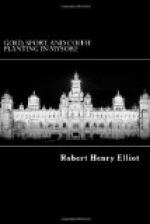the roots should not be disturbed,” is a matter
of great difficulty—I might almost indeed
say an impossibility. For, from the trampling
of the people in their passage up and down the lines,
and the dash of the rain, the soil becomes exceedingly
hard immediately after, or at least very shortly after
the rain. Here, then, the planter finds himself
between the devil and the deep sea. Is he to
leave his soil in a hardened state from the beginning
of November to the end of January, or perhaps the middle
of February, or is he to violate the axiom which tells
him not to disturb the roots till after the crop is
ripened? And here I think the condition of things
is such that he should come to a compromise, and dig
up at the end of the monsoon a space of about 2 to
2-1/2 feet up the centre of the lines, which, being
the part always walked upon, is necessarily liable
to be puddled and hardened, and then, after crop-picking
is finished, lightly dig, or pick over and stir, the
remainder of the soil, breaking, of course, all clods
at the same time. By such a process we should
prevent the central portion drying up and cracking,
and aerate laterally the rest of the soil, and at
the same time do as little damage as possible to the
roots. I need hardly say that it is of great
importance to begin with all those places where the
soil is most hardened, as, should the planter not be
able, from shortness of labour, to complete his digging
before crop, he will at least have dug those places
most urgently in need of cultivation. If the soil
of the estate is pretty even in character, the hottest
aspects will of course harden soonest, and should
be dug first, but it may so happen that a hot aspect
may have a soil of a loose and open character, while
a north aspect might have a soil of stiff character,
and here the planter must alter the rule so as to
suit his particular case.
For digging, or rather loosening the soil at the end
of the monsoon, my experience is that the four-pronged
Assam fork is the best tool, and that for the light
picking over of the whole of the soil after crop a
light two-pronged digger is best. This last tool
is shaped like a mamoty, but with two prongs rather
widely set apart instead of the broad blade of the
mamoty. It being very light, it can easily be
turned in the hand, so that clods may be broken with
the back of the tool, and it can be used by women,
which of course is of great advantage for pushing forward
the work.
Renovation pits, as they are called, were once regarded
as an excellent means of deeply stirring the soil,
but, of recent years, have fallen out of favour with
many planters, and I think justly so. These pits,
or rather trenches, are dug in the spaces between
four trees, and are generally about fifteen inches
in depth, as many in width, and about ten feet long.
Weeds and rubbish were thrown into them, and when they
were filled with these, and soil washed into them,
the pits were abandoned and another set opened.




